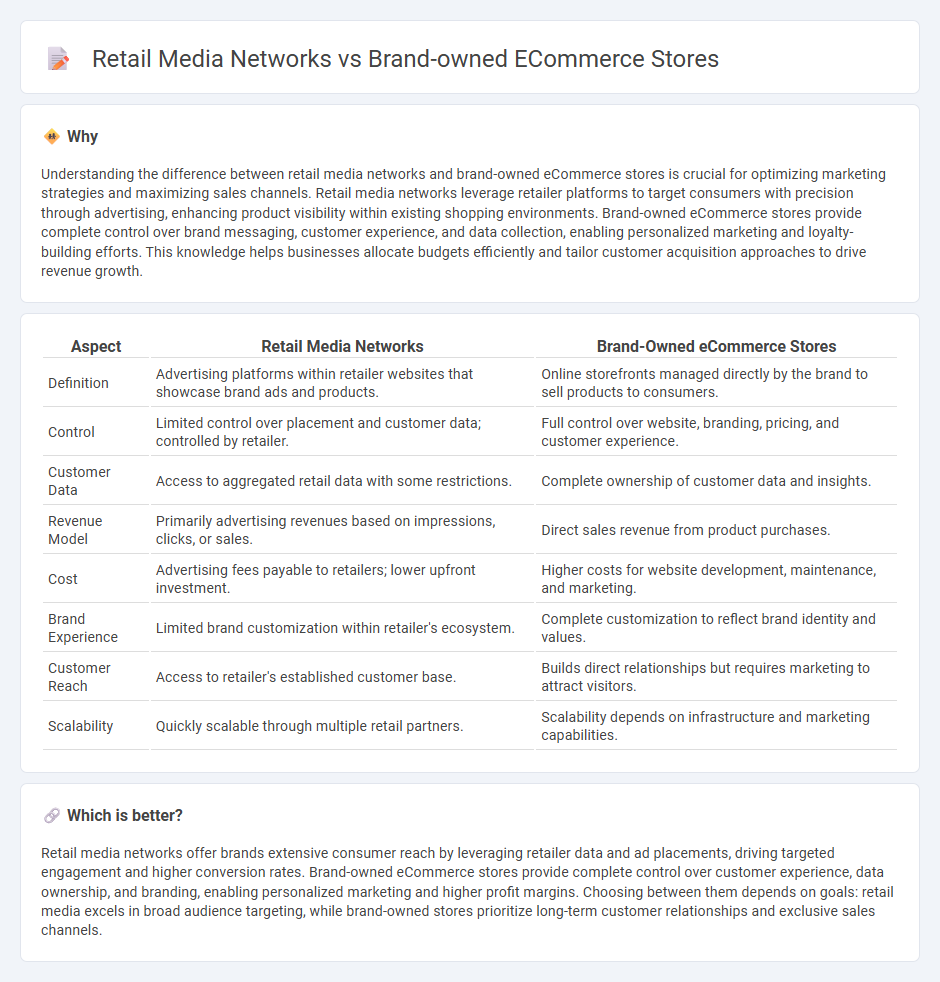
Retail media networks leverage third-party platforms to promote products through targeted advertising, generating revenue by connecting brands with ready-to-buy audiences across multiple digital touchpoints. Brand-owned eCommerce stores offer direct-to-consumer sales channels that enable complete control over customer experience, data ownership, and brand messaging. Explore the strategic advantages and operational differences between these two powerful commerce models.
Why it is important
Understanding the difference between retail media networks and brand-owned eCommerce stores is crucial for optimizing marketing strategies and maximizing sales channels. Retail media networks leverage retailer platforms to target consumers with precision through advertising, enhancing product visibility within existing shopping environments. Brand-owned eCommerce stores provide complete control over brand messaging, customer experience, and data collection, enabling personalized marketing and loyalty-building efforts. This knowledge helps businesses allocate budgets efficiently and tailor customer acquisition approaches to drive revenue growth.
Comparison Table
| Aspect | Retail Media Networks | Brand-Owned eCommerce Stores |
|---|---|---|
| Definition | Advertising platforms within retailer websites that showcase brand ads and products. | Online storefronts managed directly by the brand to sell products to consumers. |
| Control | Limited control over placement and customer data; controlled by retailer. | Full control over website, branding, pricing, and customer experience. |
| Customer Data | Access to aggregated retail data with some restrictions. | Complete ownership of customer data and insights. |
| Revenue Model | Primarily advertising revenues based on impressions, clicks, or sales. | Direct sales revenue from product purchases. |
| Cost | Advertising fees payable to retailers; lower upfront investment. | Higher costs for website development, maintenance, and marketing. |
| Brand Experience | Limited brand customization within retailer's ecosystem. | Complete customization to reflect brand identity and values. |
| Customer Reach | Access to retailer's established customer base. | Builds direct relationships but requires marketing to attract visitors. |
| Scalability | Quickly scalable through multiple retail partners. | Scalability depends on infrastructure and marketing capabilities. |
Which is better?
Retail media networks offer brands extensive consumer reach by leveraging retailer data and ad placements, driving targeted engagement and higher conversion rates. Brand-owned eCommerce stores provide complete control over customer experience, data ownership, and branding, enabling personalized marketing and higher profit margins. Choosing between them depends on goals: retail media excels in broad audience targeting, while brand-owned stores prioritize long-term customer relationships and exclusive sales channels.
Connection
Retail media networks drive targeted advertising that directly boosts brand-owned eCommerce store traffic and sales, enhancing customer engagement through personalized promotions. Leveraging consumer data from retail media networks allows brands to optimize inventory, pricing strategies, and user experience on their eCommerce platforms. Integration of these networks with brand-owned stores strengthens omnichannel marketing efforts, improving conversion rates and maximizing return on ad spend.
Key Terms
Direct-to-Consumer (DTC)
Brand-owned eCommerce stores provide DTC businesses with full control over customer data, brand experience, and profit margins, enabling personalized marketing strategies and direct engagement. Retail media networks leverage the reach and customer insights of established retailers, driving sales through targeted ads on retailer platforms but often sharing data and revenue. Explore the strategic advantages and challenges of each approach to optimize your DTC growth and customer acquisition.
Third-Party Marketplace
Brand-owned eCommerce stores offer direct control over customer experience and data, while retail media networks leverage third-party marketplaces to amplify product visibility and targeted advertising. Third-party marketplaces like Amazon and Walmart provide access to a vast customer base and sophisticated advertising tools within retail ecosystems. Explore how integrating these platforms can optimize your brand's digital strategy and sales performance.
Digital Advertising Placement
Brand-owned eCommerce stores offer direct control over digital advertising placement, enabling tailored promotional content that enhances customer engagement and conversion rates. Retail media networks leverage massive consumer data across multiple retailers, optimizing ad targeting and expanding audience reach through highly personalized campaigns. Explore the strategic benefits and best practices to maximize your digital advertising impact in either ecosystem.
Source and External Links
Top 40 eCommerce Companies in the USA for 2025 (by Web Sales) - A list of leading brand-owned eCommerce stores including major retailers like Apple, Nike, and Zara, which operate their own direct online sales platforms, showcasing prominent brand-owned eCommerce models.
14 Innovative Ecommerce Brands To Watch (2024) - Shopify - Overview of top ecommerce brands such as Amazon and Shopify and explanation that millions of brand-owned ecommerce stores exist globally, from small handmade sellers to multinational brands running their own eCommerce websites.
21 Best Ecommerce Stores: Get Inspired With Designs We Love - Examples of successful brand-owned eCommerce stores like Burrow and Skullcandy, highlighting how these brands use their own online stores to build strong branding and customer experience.
 dowidth.com
dowidth.com